Welcome back to our Weekly Roundup, where we cover some of the many stories from home and abroad that caught our eyes recently. This week’s header image is courtesy of @ScootFoundation on Twitter, and pretty accurately captures the vibe and the weather of early 2023.
The week in Greater Auckland
We’ve had a quiet start as we ease back into things following the Christmas/New Year break:
- On Tuesday I took a look at some of the major things we will be keeping an eye on in the year ahead.
- On Wednesday I covered our terrible road safety record, and recent attempts by officials to lower their targets for improving it instead of lifting their game.
Auckland’s Top PT User
Stuff revealed just before Christmas that Auckland’s most prolific PT user made a whopping 3,400 trips between January and the end of November 2022, and all for free. Impressive. Who is this masked (wo)man?
Auckland’s most frequent public transport user took about 3400 trips this year – and didn’t pay a cent.
The person travelled 18,000 kilometres around the Super City from January to the end of November, according to Auckland Transport HOP card data.
That’s the equivalent of about 10 trips a day over 334 days, with an average journey distance of 7.8km. Sixty-four per cent of their journeys included a transfer to another service.
But Auckland Transport made no revenue from the person – because they’re over 65 years old and entitled to Super Gold concession, which gets them free travel after 9am on weekdays and all day on weekends and public holidays.
Christchurch is pedaling ahead
While up here in Auckland we seem to have fallen off the cycleway delivery track – again – Christchurch is pedaling on, casually rolling out a number of projects the length and quality we can only dream of:
Progress on Christchurch’s $300m plus cycleway network has been plagued by the impact of Covid-19 and KiwiRail delays.
Despite this, four sections of various cycleways were completed last year, and further sections are due to be complete this year. Planning work has not even begun on three cycleways including the highly-anticipated Avon Ōtākaro cycleway through the former residential red zone.
When complete, 101km of cycleways will be built as part of 13 major routes criss-crossing the city.
New York City Light Rail
Mode debates are not unique to New Zealand. The latest one to break out is in New York where Light Rail was chosen for the Interborough Express (IBX) – essentially 22.5km orbital/crosstown line through Brooklyn and Queens, using space in an underused freight corridor to connect up the two boroughs and linking with up to 17 subway lines.

Much like our own debate about light rail here, one thing that’s noticeable is just how much it’s costing compared to overseas examples. The plan comes in at NZ $385 million per km, which is similar to what Auckland’s light rail team most recently came up with for a surface-travelling route here before deciding to prefer the more costly tunnelled option.
Closest equivalent to IBX I've seen is the (excellent) Tram 11 Express, a circumferential tram-train line on north side of Paris region that opened in 2017. It's half as long, cost €611 million, so about €90 million/mile. IBX would be $390 million/mile, about 10 years later. https://t.co/3D7ob1AqR0 pic.twitter.com/sHb9lPCM5y
— Yonah Freemark (@yfreemark) January 11, 2023
The IBX would connect up to 17 subway lines + @LIRR serving nearly a million riders each day.
Travel times between Brooklyn and Queens could be reduced by up to 30 minutes each way, depending on travel distance. pic.twitter.com/YvXMDSg32k
— MTA (@MTA) January 10, 2023
The Coyle Park challenge returns
Sadly this summer once again saw the return of the Coyle Park challenge. Inconsiderate parkers, and a lack of enforcement, means buses can’t use the turning circle at the end of the line at Point Chevalier Beach.
This results in the 66 buses having to cut their journeys short, with short or no notice, leaving PT users with a long walk, or worse, waiting at a bus stop for a ride that will never come.
The bus stop that passengers need to make their way to (or from) is 1.25 km away. This is ridiculously too far, especially for people with disabilities or those who perhaps have children with them, or even just a bunch of beach gear.
And, while AT has added an electronic board to Coyle Park to announce these last-minute bus changes, those using other stops nearby have no way of knowing what’s going on. Not everyone has a smartphone or follows AT’s Travel Alerts on Twitter.
This issue has been going on for many years now and happens predictably on summer weekends and public holidays, especially a couple of hours around high tide. It’s absurd that AT haven’t found a way to fix it.
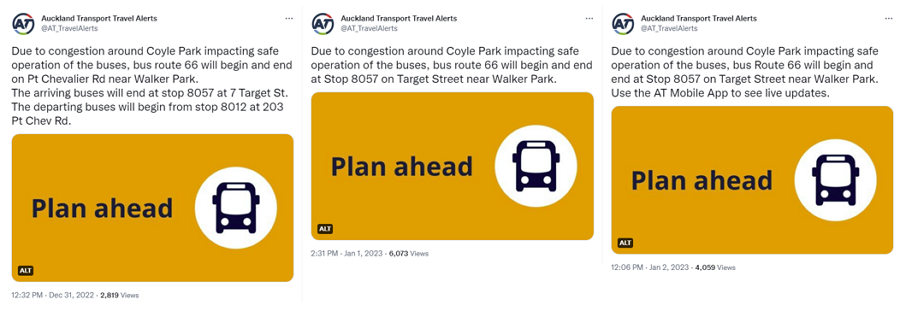
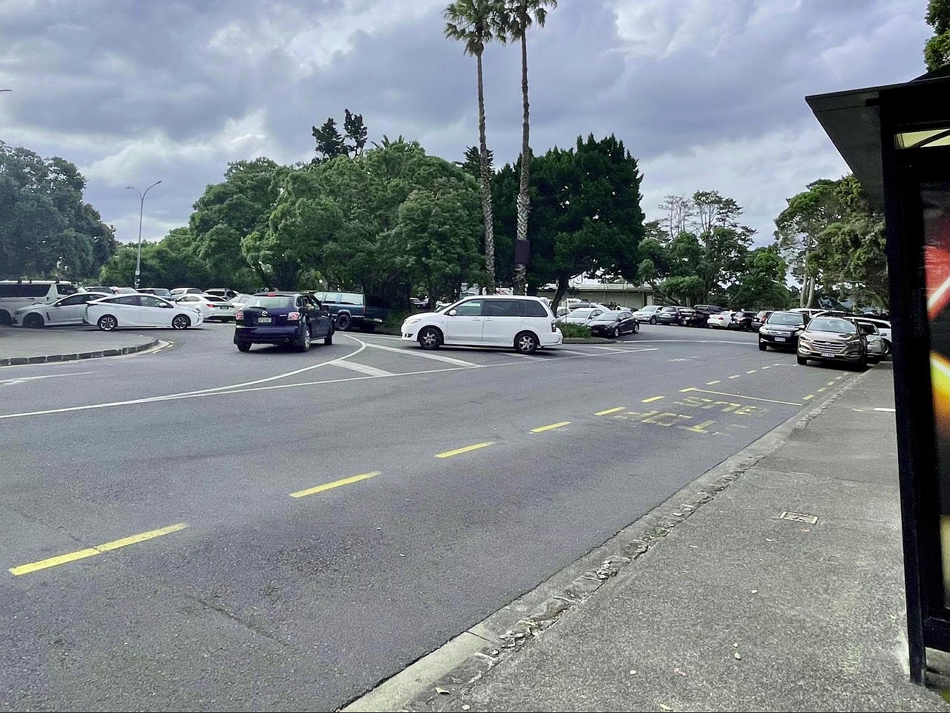
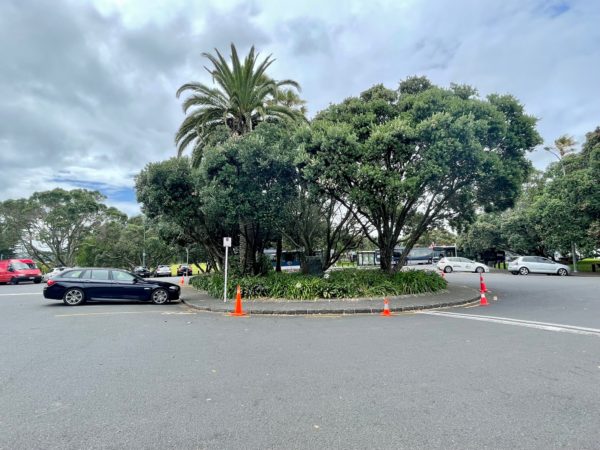
On a related note, it seems Auckland Council’s new Transport Committee Chair is aiming low.
Auckland Council’s Transport Committee chair says his priority this year will be ensuring commuters get clear communications if city services are delayed or cancelled.
John Watson said without this, or the necessary substitutes to make up for it, people would continue to be pushed back into their cars rather than making use of the city’s public transport system.
“People have got all variety of apps these days for monitoring what’s going on, and the one consistent thing you hear from commuters is ‘we just want to know what’s happening, and we want to know with a reasonable lead-in time'”.
How about fixing the issues causing PT services to be cancelled in the first place?
Peak AT is running a (presumably expensive) ad campaign for services you're not running pic.twitter.com/TNMO9DnlW2
— scoot! (@ScootFoundation) January 10, 2023
They’re using WHAT
If you’ve seen some really old and noisy buses around the city recently, you’re not alone. It seems that all AT could manage for rail replacement buses during the rail shutdown are vehicles that should have been in a scrap yard decades ago.
The bus in the image below was first registered in NZ in 1979. If this is the kind of quality we can expect for the rest of the rail shutdowns, then things are much worse than feared – not to mention the appalling frequencies.
Have you seen the buses they’re using? Not joking. Noisy, no aircon. Seriously. pic.twitter.com/IsisDIPMv8
— LiNZ (@LinzLinz44) January 9, 2023
Harbour Bridge scooter ride
There was a news item earlier in the week after someone was spotted riding a scooter over the Harbour Bridge. Police eventually found the man and gave him a written warning, putting some of the blame on social media although there was no comment from the person themselves.
But let’s also not forget that this wouldn’t be an issue if we had a safe way for people to cross the bridge by foot, bike or other micromobility device.
Early morning organ donor. pic.twitter.com/SMe5q86Td9
— Rafael Contreras Rodríguez (@contrer_as) January 9, 2023
The article also took a moment to highlight the ACC costs of scooter accidents, which was highlighted in other (unrelated) articles over the holiday period, conveniently leaving out out the ACC costs of road crashes, which is several orders of magnitude higher.
saw this story in the Herald and wondered how the cost of car crashes compared in the same time period so I flicked an email to the ACC media team. Anyway I think I've come across another big story for u guys @nzherald pic.twitter.com/LRjXShZ9qT
— Hayden Donnell (@HaydenDonnell) December 31, 2022
Also on safety and topical billion-dollar stories: this looks like a crash waiting to happen.
looking forward to the first video of a tesla trying to drive directly through it https://t.co/QKlxxC2ieW
— flglmn (@flglmn) January 11, 2023
Urban Living
Auckland Council has recently published a few wonderful articles and videos of city centre residents talking about what they love about the city and what they want to see in the future. This is related to the midtown works such as Te Hā Noa, the Victoria St Linear Park, which is due to start construction this year.
https://www.youtube.com/watch?v=cZCfUD6TwXw&ab_channel=AucklandCouncil
And speaking of the city, people gravitating to it, and transforming streets into social spaces… here’s a great shot of Victoria St on New Year’s Eve.
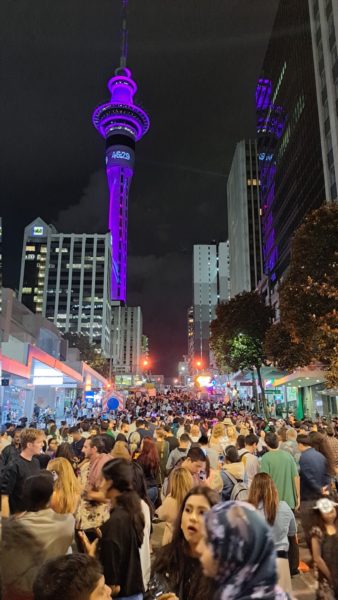
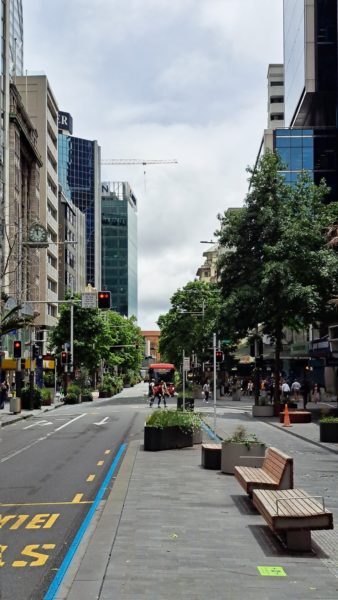
This Week in Flooding
Sadly, there’s been no shortage of New Year examples for this section that began a whim and has become a regular feature accounting for one of most visible impacts of climate change on towns and cities.
Here in Aotearoa, the remains of Cyclone Hale battered Northland, the Coromandel, and the East Coast in particular, leaving in its wake all manner of local devastation, scoured-away waterfronts, and a long list of roads closed by floods, slips, and washouts.

This really puts all the talk of potholes into perspective, and is also no doubt playing havoc with the ambitious nationwide road repair programme planned for over the summer.
And NIWA has confirmed that 2022 was the hottest year of our lives (so far), with NIWA Principal Scientist Chris Brandolino clearly noting: “Climate change continues to influence New Zealand’s long-term temperature track. Climate change makes extreme weather events more likely, it makes them more frequent, and it makes them more intense.”
There’s another cyclone on the radar for next week, by the way.
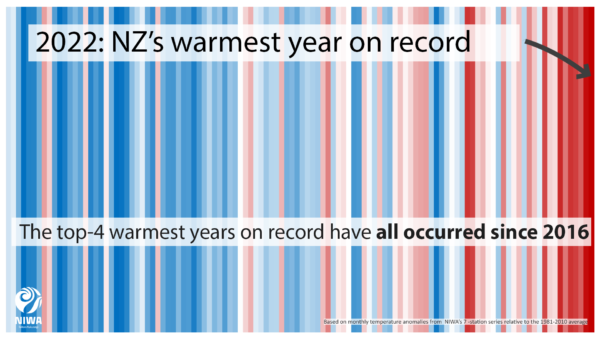
California has been experiencing some of the worst flooding it’s ever seen, as massive storms brought torrential rain to a landscape baked hard by a long drought and unable to absorb the water, resulting in losses of life, the displacement of thousands of people, and giant sinkholes swallowing cars.

The visual metaphors for the tragic dumpster-fire-of-our-own-making that is climate change just… keep… coming.
THIS SAYS IT ALL#SantaBarbara #Montecito #Goleta #CAwx pic.twitter.com/JZdWT9YUro
— Santa Barbara (@onsantabarbara) January 9, 2023
Meanwhile, similar scenes in Portugal… prompting the thought, is the Auckland light rail team thinking about what impact flooding might have on their stations? That would be good to know.
For anyone who still wonders why XR members glued themselves to a tube train, this is Porto, Portugal. Would you want to be in that underground station? pic.twitter.com/4vKpVz0qGC
— Green Cllr Scott (@cllrLisaScott) January 7, 2023
Short bites
Love this cutaway graphic from Dunedin City Council, such great visual comms:
Oooh I’m a sucker for a good cross section, me.
Love this @DnCityCouncil schematic of what’s being navigated underground as part of the George St upgrade pic.twitter.com/oEhZuvePux
— Aaron Hawkins (@A_G_Hawkins) January 8, 2023
We could really do with this style of graphic to explain many of the street upgrade projects in Auckland. Especially those where also adding a cycleway gets blamed for the full scale of cost and disruption – when the real cost is in uncovering and dealing with all these services, many of which haven’t been maintained in decades.
Or, we could wait for the real-life images of California-style sinkholes, to show why we should have acted sooner… what do you reckon?
In some good news, the government’s EV rebate looks to be working well, with EV sales exceeding expectations and pure EVs more than doubling on the year before (in what was a bumper year for all car sales).
The obvious question: when will we see a similar policy extended to e-bikes, which offer even more bang for buck? Surely a no-brainer for this or any government, given the demand for alternatives and the fact we’re one year closer to all the carbon-reduction targets we’ve set.
Electric vehicles may be better for the environment than gas-guzzlers but they’re shaping up for being more dangerous on our roads if involved in a crash, because they’re so much heavier.
Yeesh. Electric SUVs and trucks are so heavy that crash tests don't work for them.
In a collision, these things can pulverize another vehicle — let alone a cyclist or pedestrian.https://t.co/VE3LFD9HCR
— David Zipper (@DavidZipper) January 2, 2023
Risk planning is critical for cities and the people who live in them. If this post seems heavy on climate change, that’s because… well, it underpins most of the risks we now face. Anything we can do to shift this is absolutely vital.
To be helpful, I simplified the just published @wef "Top 10 global risks over the next 10 years":
1 Climate change
2 Climate change
3 Climate change
4 Climate change
5 Climate change
6 Climate change
7 Other
8 Other
9 Other
10 Climate changehttps://t.co/ArWiPOZeUx pic.twitter.com/MzX23QaIPz— Assaad Razzouk (@AssaadRazzouk) January 12, 2023
The clean energy transition is well under way, with optimistic signs for 2023.
Zero-emission vehicle targets now cover 40% of the world’s auto market.
What is needed now is a relentless push to remove barriers to the transition, and the implementation of pragmatic policies that can deliver on the goals we have set. Greater competition among countries could indeed support this: it is a sign that countries see the opportunities in the energy transition more clearly than ever, and are gearing up to take their piece of the pie.
It’s been said that something akin to a wartime mobilization would be needed to successfully tackle climate change. That might just be what we are beginning to witness.
With France and other countries moving to ban short flights, which have disproportionate climate impact, should New Zealand consider the same approach? An interesting story by Olivia Wannan from Stuff’s climate team on some of the local opportunities and challenges for intercity travel.
And here’s a really decent long read must-read for your weekend: Rebecca Solnit in the Guardian, on why we need new and better stories, to solve the climate crisis:
In order to do what the climate crisis demands of us, we have to find stories of a livable future, stories of popular power, stories that motivate people to do what it takes to make the world we need. Perhaps we also need to become better critics and listeners, more careful about what we take in and who’s telling it, and what we believe and repeat, because stories can give power – or they can take it away.
We’ll keep doing our best on this front – and we really appreciate your input, too. That’s our roundup for the week. What else have you spotted out there? Feel free to share in the comments.
Have a good weekend, stay warm and dry!


 Processing...
Processing...
Did Auckland Transport really make no revenue from the most prolific PT user? The government funds daytime supergold fares so presuming a chunk of the travel was outside the afternoon peak there would have been some money flowing AT’s way.
Truth Known any money that they got out the Gold card pot went straight to the top Brass at AT pockets as a bonus possibly .
‘Electric vehicles are so much heavier’…. are they?
Wiki tells me a Model 3 is 1600kgs. The kerb weight of a Camry is 1655kg. A 40kwh Leaf is 1600kg, a 2WD Xtrail is 1550kg.
This is kind of a lazy anti-EV talking point and I’m disappointed to see it here. And that’s before you get into things like where the centre of mass sits for EVs and how that makes them generally easier to control.
Quick search online for comparable models in ICE/EV has the Hyundai Kona (which is only a small SUV, the points being made above relate to full size SUVs and trucks I believe) has the EV equivalent approximately 20% heavier which does mean more energy to be dispersed in the case of a crash. Whether that constitutes ‘much heavier’… dunno. Full size SUVs and trucks are already too dangerous for anyone/anything on the receiving end of their momentum/energy in the case of a crash.
It really comes down to what you’re comparing it with. If you’re not having to carry around a complex heavy AWD system and bigger engine, there’s less of a weight premium for an EV of the same size. The Kerb weights of the E Tron and Q7 are broadly the same. I’m guessing that difference is more pronounced as cars get smaller and a four cylinder engine gives you less weight back to cover the battery penalty, although I’m guessing the Tesla is equivalent sedan weight simply because of their chassis-packaging and generally advanced cell densities compared to some others. I suspect the Kona will get closer to the ICE model once it inherits the 800v tech and the goodies from the Ioniq 5.
The point is, a blanket statement like “electric vehicles are so much heavier” is clumsy given the cited example related to American road behemoths which are oversized in ICE form, and that there are instances where EVs are pretty much already the same weight as their equivalent combustion models – which will only go one way over time.
The are referring to SUV Ecars, like Rivian and Ehummer.
Batteries weight a lot more than petrol. The more the vehicle weights the more this is true. If you are going to do comparisons, do like actually comparable cars such as the Renault Zoe 1500 kg and the Renult Megan 1000 tons.
“Electric vehicles may be better for the environment than gas-guzzlers but they’re shaping up for being more dangerous on our roads if involved in a crash, because they’re so much heavier.”
No caveats here that I can see to do with SUVs. That’s literally the issue I have. It’s blunt, and debatable. There’s already enough misinformation when it comes to EVs that’s easily dispelled using a simple Google search. There are plenty of comparable cars where the EV version is at best 100kgs over the weight of the equivlant ICE model. The Megane RS and the Zoe appear to be about 50kg apart in terms of unladen weight, but I’m not sure the Zoe is still sold in our market anyway.
The rail replacement bus operation is seriously embarrassing. It just shows how crazy AT’s contracting environment is – at the time that this Murphys dunger was deployed, there would have been loads of AT branded buses sat in operator depots doing nothing. But Murphys won the contract and had drivers, so rather than procure Murphys drivers and use AT branded buses from another operator, they do this. Glad I didn’t need to use PT over the xmas period. Truly awful…
Still some of the Dungers didn’t have card readers so the journey was free. But I don’t agree the rail replacement service is seriously embarrassing. Its improved over time if we keep practicing it will get better and better. And we might have plenty of practice by the look of things. Passengers are learning how to use it.
Has any new / temporary bus lanes or other bus priority been put in for the replacement buses?
I would love the answer to this, too.
That would be a no.
What it really shows is how badly underfunded and substandard the MoE contracting environment is. The only reason those buses are still on the road is that the operator can get away with using them for hauling children to and from rural schools on Ministry of Education contracts, and isn’t forced to bring their fleet more up to date like the AT Metro operators are.
I agree its a really bad quality of service, but I can also see the practical constraints. The Metro operators with their current staffing struggles will want to take the opportunity for their drivers (and cleaners and maintenance staff) to use up some leave during their relatively short period of down time over the holiday period. So they likely don’t have much capacity to take on the extra work. Whereas the school bus operators with their longer periods of school holiday down time throughout the year probably do have greater capacity to deliver the extra services without worrying about their staff getting enough leave time.
The Clapped out ones on the Western line were from Kiwi Coachlines and Richies , the Richies where in good nick and after talking to one of their Drivers he said that his normal job was driving School buses and when this was over he would be at home doing nothing until School restarted .
What I have seen is kiwi Coachlines is primarly a School run company so the dungers .
And at least this week AT were running the Rail Buses out west on the 1/2hr but the notification I saw was at Custom St this afternoon and nowhere else .
As for the Large uptake of EV’s that might get a knock on the Head when Road User Chargers finally come into effect and they will realize they aren’t that cheap to run , like with a Diesel .
Ah, so my ‘fuel’ related-running costs per year would go from about $400 to about $1,400? As opposed to the $3K that my small hatchback cost me a year in fuel? Still sounds like a pretty good deal, plus it has the bonus of making people finally shut up about how EVs don’t pay RUC.
Can I pay a bit more and make the lithium mining DGMers go away as well?
EV RUC extension to March 31, 2024 , So it will Happen one day .
https://evsandbeyond.co.nz/ev-ruc-extension-to-march-31-2024/
https://www.stuff.co.nz/motoring/evs/125666247/government-extends-ruc-exemption-for-evs
Very interesting video just, containing a bit of history etc: “Architect Breaks Down 5 of the Most Common New York Apartments”:
https://youtu.be/RL7BECNn-RI
AT’s ClusterCircus at the Trolley Bus Circle of Coyle Park is embarrassing and just shouldn’t be happening. It has been a multiple-year demonstration that enforcement after the fact doesn’t work. Year after year, stranding people and putting everyone off using the services simply shows a lack of understanding that a core part of managing a sustainable public transport network is keeping services reliable.
In the case, the circle was created for a trolley bus. Return it to public transport use so that people can use the bus.
Put in a bus gate.
Tram turning circle.
https://collection.motat.nz/objects/126427/tram-237-at-point-chevalier-beach
OK, that’s really interesting thanks. My understanding is that Auckland trams were bidirectional and didn’t use turning circles except in a couple of places where they were used to stack trams during sports events, and the railway station. I had thought the facility at Coyle Park was built expressly for trolley buses to turn around. That photo would suggest that for this to be true they put in tracks for the trams so that both trams and trolley buses could be used…?
More likely, perhaps, is that this was indeed one of the rare tram circles, reflecting the tidal nature of the passenger journeys, enabling more tram trips in the morning to the beach and park, and more trips back at the end of the day. I wonder if anyone can find a photo showing the trams stacked there.
In either case, the circle was built expressly for public transport needs, not for parking private vehicles.
Can’t AT put in barrier arms to stop cars and give the Buses a device like a garage door opener to raise the arm as they come in/out .
Yes, they can. Yet, here we are.
AT would rather make people without a car walk over a kilometre extra to get there, holding whatever gear and children they have brought with them. Revealing, eh.
Excellent roundup thanks, Matt. And Scoot, I just love that photo.
I’ve always assumed the top 10 global risks are the ones we don’t know about, ie all black swan events. replicating nanobots gone haywire, genetically engineered terrorist virus gone haywire, asteroid out of nowhere, particle accelerator breaking reality, alien invasion, climate change solutions gone wrong like blotting out the sun etc.
Experts estimate that climate change will result in 80 million deaths over the next 80 years. That lots of dead people, but the remaining 99% of humanity will just continue to try and get on with life as we always have. Except we’ll be under water and trying to cool down.
What is the point you are trying to make? Climate change is a foreseeable catastrophe which will have huge impact on (almost) everyone. We can act on it or we don’t because an alien invasion would render our efforts moot.
In addition to the 80 million deaths there will be probably a couple of hundred million additional refugees because of famine, draught or war over resources such as water.